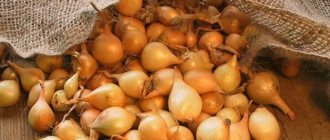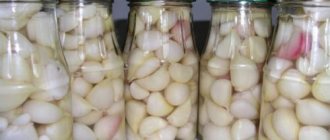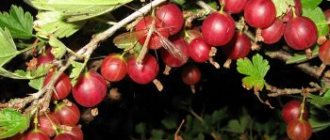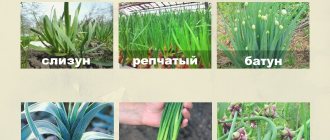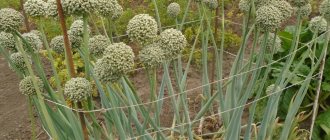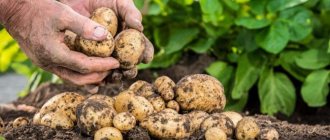Garlic is an extremely widespread crop. Typically, this spicy vegetable is grown year after year from its own planting material. However, there are very different varieties of winter garlic, differing in physiological characteristics, ripening time, taste and other characteristics.
The official lists of the State Register of Breeding Achievements of the Russian Federation include more than eight dozen varieties of this onion crop. We invite you to familiarize yourself with photos and descriptions of the most sought-after and popular varieties of garlic, as well as their characteristics and the most important data.
Lyubasha
A large-fruited variety bred by Ukrainian breeders, but perfectly adapted in our country. Grown by cloves and aerial bulbs. Lyubasha's garlic is undemanding in care, not picky about the quality of the soil, produces stable yields, and demonstrates truly amazing shelf life - up to 10 months.
Characteristics:
- for Ukraine, Belarus and Moldova, but is also successfully grown in Russian spaces;
- ripens in an average period of 95-105 days;
- the weight of one garlic clove is 100-120 g (sometimes more);
- There are usually about 4-8 cloves;
- integumentary scales are white with a slight pinkish tint and purple veins;
- the pulp is crisp, white;
- the taste is sharp, piquant, pronounced;
- 2-3.5 kg are collected from 1 m2.
Lyubasha's garlic was created for southern latitudes, but has surprisingly good frost resistance, withstanding even the harsh Ural winters.
Recommendations
It is best to place garlic after legumes, pumpkin, cabbage, and early greens. There is no need to plant garlic after potatoes, onions, or tomatoes, as they suffer from the same diseases and have similar pests.
Planting with new manure has a negative effect. Garlic should not be placed in lowlands, where melt water accumulates during a thaw, or in elevated areas, where a frosty blizzard blows up the snow cover and the plant may die.
Phosphorus and potassium are added during the main tillage of the soil. Nitrogen fertilizers are added in the spring, when young shoots emerge. A mixture of microfertilizers or soaking the cloves in a solution of a mixture of microelements and fungicidal disinfectants is very useful. Soaking aerial bulbs for 12 hours in humic fertilizer before sowing improves the yield by 20-30% and increases the probability of germination by approximately 2 times.
See also
How to properly plant garlic in open ground, soil preparation
Read
Dobrynya
A widely known domestic variety, planted with both cloves and single cloves obtained from bulbs ripening at the ends of the arrows. Dobrynya tolerates drought well, but does not like waterlogging, so the soil between the rows needs to be loosened often. The variety has an average shelf life of about 6 months.
Peculiarities:
- suitable for cultivation in all Russian regions;
- the harvest is ready for harvesting in the mid-late period - 120-130 days;
- the average weight of a large, round onion is 50-60 g;
- number of cloves - 8-12 pieces;
- dry integumentary scales are white-gray with barely noticeable purple veins, leathery scales are darker;
- The inner pulp is dense and juicy. light cream, almost white;
- the taste is sweetish, semi-sharp;
- yield - 2.1-2.5 kg/m2.
Dobrynya is valuable for the alignment and calibration of the heads, which grow almost the same size, as if by selection.
Jagged
Mid-season, bolting, high-yielding variety. The bulb is round and large. The color of dry scales is yellowish-white. The variety is resistant to fusarium.
| Taste | Number of teeth | Bulb weight, g | Productivity, kg per 1 sq.m | Keeping quality |
| Peninsular | 4-6 | 54-72 | 1,2 | good |
Komsomolets
An ancient variety of garlic, grown in household plots and summer cottages for more than 40 years, through the planting of onion segments and seed bulbs. Komsomolets is demanding on lighting; in shading it turns out small and contains a small amount of essential oils. The shelf life is short - 4-5 months.
Characteristics:
- was bred for the Central Black Earth Region, but over time it spread throughout Russia;
- mid-season variety - 100-120 days;
- head weight - about 30 g:
- cloves per onion - from 6 to 12 pieces;
- fresh fleshy scales are brownish-violet, lighten as they dry, becoming dirty whitish with a lilac tint;
- the flesh is beige-white;
- the taste is distinctly pungent;
- harvest from 1 m2 - up to 1.35 kg.
Garlic Komsomolets is tolerant of high soil moisture in the garden, but tolerates drought with great difficulty.
Cavalier
A relatively new, large-fruited, frost-resistant variety, which is planted with heads divided into cloves or for the purpose of renewal every 3-4 years, using airy bulbs. Cavalier does not tolerate dense plantings, responding by chopping the bulbs. Stored for 6-7 months.
Peculiarities:
- approved for landing in all regions of Russia, but has good reviews from neighboring countries of Belarus and Ukraine;
- ripening time is average - 95-110 days;
- bulb weight - 65-85 g;
- cloves in one head - 8-12 pieces;
- leathery scales - fresh - dirty purple, dry - white;
- the inner pulp is slightly yellowish, dense and juicy;
- semi-sharp taste;
- collection per 1 m2 - 2-3 kg.
Garlic Cavalier is distinguished by its low susceptibility to pests.
Reviews from gardeners
Most gardeners who plant Kharkov purple garlic are satisfied with the result. It is recommended to plant them along the edges of beds with strawberries or wild strawberries. This way the cloves will turn out much tastier and juicier.
Garlic of this variety can be used raw, as an additive to meat or salad, and for canning. The only thing is that in its raw form the taste may seem too spicy, so cooking it requires less than what is indicated in the recipes.
Bulbs store well if the minimum conditions are observed, otherwise they may begin to rot or dry out. It is better to choose a dry room with an average air temperature, then you can enjoy the healthy fruits for a long time.
Agate
The brainchild of Ural breeders, it reproduces with the help of cloves and bulbs that go through the one-claw stage. The variety is unpretentious, but does best on loose and chemically neutral soils. Keeping quality is good - up to 6-7 months.
Characteristic:
- can be grown in all regions of the Russian Federation;
- mid-ripening - reaches maturity after 100 days on average;
- round head weighing about 48 g;
- cloves per onion - 9-11 pieces;
- the leathery scales are at first brownish, then as they dry they become violet-white, mottled with dark anthocyanin streaks;
- the flesh is white;
- the taste is pungent, considered one of the most pronounced;
- yield per 1 m2 - 0.8 kg.
When planting Agate seed material in the form of bulbs, it is necessary to take into account that its germination rate will not exceed 75-80%. Therefore, sowing should be done with a reserve.
Read: when and how to properly harvest garlic from the garden in each region
Shadeika
A well-proven, promising new product that belongs to the group of the largest varieties of garlic. It is grown both from cloves and seed bulbs using traditional technology, without any special care. The stated shelf life is up to 10-12 months.
Peculiarities:
- recommended for cultivation throughout the Russian Federation;
- ripens in an average period of 105-110 days;
- the head is large - 80-100 g, weighing (maximum - 146 g), rounded-flat;
- number of cloves - 4-8 pieces;
- dried scales are painted white, leathery scales are creamy;
- the flesh is white;
- the taste is spicy and semi-sharp;
- from plantings with an area of 1 m2 they collect up to 2.5-4 kg (up to 5 kg).
The Shadeika variety is named after the settlement - the village of Bolshaya Shadeika, Perm Region, where it was bred by local farmer I. Dmitriev and professor-breeder Suzan V.G.
Bogatyr
A variety of garlic that has recently appeared on the market, fully lives up to its name, can be planted either with aerial bulbs, through the stage of single-claw bulbs, or with cloves. Duration of winter storage is up to 6 months.
Characteristics:
- for any regions;
- mid-season variety - 100-105 days;
- the onion is very large “heroic”, weighing 80-115 g (often 120 g);
- the teeth are also large and there are not many of them in the head - 5-7 pieces;
- leathery scales are colored purple, dry scales are white;
- the pulp is dense, white;
- the taste is pronounced, pungent;
- harvest from 1 m2 of Bogatyr plantings is 2.2-2.5 kg.
According to the authors, Bogatyr belongs to the best varieties of extra-class garlic, distinguished by its enviable large fruit, but at the same time unpretentiousness in care.
Pests and diseases
Purple garlic is very weakly affected by diseases; pests are also not afraid of it. Most gardeners specifically plant garlic bulbs to provide protection for other plants.
See also
Description of the garlic variety Polesie Souvenir, features of cultivation and careRead
But it is still better to use preventive measures to prevent diseases. Most often, plants are infected with fungal diseases, for example: bacterial rot, black mold or fusarium. You can fight them with the help of fungicides and other solutions, depending on what can affect the garlic. Often, simple digging along with the destruction of weeds can greatly reduce the likelihood of damage.
Sail
Quite an old variety, bred more than 30 years ago, planted with bulbous seeds and cloves from a divided head. Caring for Parus is standard; this garlic grows on different soils, giving a decent harvest under almost any conditions. Shelf life - 6-7 months.
Peculiarities:
- for cultivation in all regions;
- the average time to reach ripeness is 96-108 days;
- market weight of one onion - 30-47 g;
- 7-10 cloves in the head;
- the teeth are covered with brownish scales with purple veins, dry integumentary scales are grayish-white with a purple tint;
- the inner pulp is medium-dense, white with a subtle yellowish tint;
- the taste is spicy, distinctly pungent;
- the minimum yield without irrigation is 0.96 kg/m2, with regular watering of plantings - up to 1.89 kg/m2.
The positive qualities of Parus garlic, which explain its demand, include its winter hardiness, as well as its low susceptibility to bacterial rot and stem nematode.
Advantages and disadvantages
The main advantage of Kharkov garlic is the stability of the harvest; in addition, it stands out due to its taste. Garlic arrows can be eaten, for example in salads or in garlic sauce. Boiled arrow greens are even considered a delicacy.
This crop is unpretentious and is not at all difficult to grow. Caring for plants will not take you much time, money or special effort. In addition, Kharkov garlic is resistant to cold temperatures and theoretically it will grow even during low temperatures, down to 0°, except that the bulbs will not be as large as at normal temperatures.
Gribovsky Yubileiny
The only officially registered variety from the Gribovsky garlic line. It reproduces, like all other dart species, with the help of seeds collected from the dart bulb and cloves. Gribovsky Yubileiny is distinguished by its excellent adaptability to any climatic conditions. Keeping quality - 5-6 months.
Characteristics:
- recommended for cultivation in any region of the Russian Federation, Ukraine and Belarus;
- average growing season - 83-122 days;
- The average weight of one onion is 22-44 g.
- number of aligned, wide cloves - 5-8 pieces;
- the color of the scales of the cloves is faded yellowish-violet, dry integumentary scales are violet in color with darker veins;
- the pulp is whitish-cream;
- characteristic garlicky, spicy taste;
- The yield from each m2 is about 1.25 kg.
Gribovsky Yubileiny, as stated in the description of the State Register, is almost not affected by harmful insects and diseases.
Which varieties shoot and which do not shoot?
Garlic varieties come in bolting and non-bolting varieties. Most gardeners prefer non-shooting garlic, although many, on the contrary, consider it more productive and tasty.
Bolting garlic has a flower arrow at the base of the head. Some of it remains even after the harvest is harvested. Among the winter varieties, these include “Kharnas”, “Nazus”, “Komsomolets”, “Polet”, “Junior”, etc. Of the spring varieties, only “Gulliver” shoots - this is its distinctive feature.
Garlic that does not have arrows has small cloves arranged in several layers. The spring subspecies include “Abrek”, “Permyak”, “Moskovsky”, “Victorio”, and the winter subspecies include “Losevsky”, “Podmoskovny” and others.
Alcor
Bred at the end of the last century at the Siberian Academy of Sciences, this variety of winter garlic produces stable yields and is very undemanding to care for. You can plant it with bulbs, which are unusually large in Alcor, or with cloves. The average shelf life is 5-6 months.
Peculiarities:
- was originally included in the register for the West Siberian region, and is also suitable for other regions;
- The average duration of the growing season is 87-98 days;
- rounded heads are dense, but not too large - 13-36 g;
- pink-violet teeth are large and there are few of them in the head - no more than 4-6 pieces;
- the outside of the bulbs is covered with pinkish-purple scales, mottled with dark streaks;
- inside the cloves there is white, crispy flesh;
- the taste is described as pungent;
- marketable yield - 0.3-0.35 kg/m2.
A disadvantage of Alcor is considered to be susceptibility to certain viral diseases, in particular yellow dwarfism.
Read: 7 best ways to store garlic at home
Types of garlic
Classification of crop varieties is carried out according to several criteria:
- planting season - for winter and spring crops;
- purpose - canteens and technical;
- shooting abilities – shooters and non-shooters;
- colors - white and pink-violet.
Each of the listed characteristics indicates the presence of certain qualities in the plant, only the color of garlic is just a distinctive feature. The surface shell (husk) has one color or another, which says practically nothing about belonging to the species. Most often, the color depends on the planting season: white is typical for spring plants, pink-violet for winter plants.
Although there are exceptions to this rule, for example, winter white garlic variety “Messidor” of Dutch selection. In other words, the color of the outer shell does not indicate the presence of any specific properties, but division on this basis exists and is used to indicate varietal identity.
By planting season
Depending on the timing of planting in the ground, all varieties are divided into 2 groups: winter and spring. Winter crops are planted during the fall, when the soil has cooled to +6°C, a month before the onset of frosts characteristic of the region. In terms of timing it falls out:
- in the Northern and Ural Federal District - on the first days of September;
- in the middle zone - for October;
- in the south of Russia - in the first ten days of November
Related article:
Secrets of proper harvest storage: 8 ways to preserve harvested garlic until spring
If planted earlier, the cloves will have time to take root, germinate and begin to develop in the fall. If you miss the right period, the planting material will freeze. Therefore, you need to strictly adhere to the recommended planting time.
For fertile, well-fed and cultivated soil, a deep (from 10 cm) planting is suitable, preventing damage to the cloves and accelerating the emergence of seedlings in the spring. If the nutritional value of the soil is in doubt, humus is added to the planting furrows.
The standard depth for winter planting is 7 cm, and covering with agrofibre is not required, since the crop is cold-resistant. If winters in the region are frosty and snowless, it is recommended to mulch the beds with straw.
Spring plants are planted in the spring after the soil has warmed above 0°C, planting the cloves 3 cm deep. In central Russia, planting dates are in mid-April, and the first harvest can be harvested in early summer.
The main differences between winter and spring varieties are shown in the table below.
| Parameter | Winter | Spring |
| Landing dates | September–October depending on region | April–May, when the earth warms up to at least 0°C |
| Number of teeth | Up to 15 pieces | Up to 25 pieces |
| Average weight of 1 onion | up to 200 g | up to 100 g |
| Time of consumption/use for other purposes | Summer-autumn season | Autumn-winter period |
| Storage duration | Until midwinter | 12–18 months |
| Planting material | Teeth, bulbs | Teeth |
| Shooting | Mostly shoots | Practically does not shoot |
| Harvesting | End of June – first half of July | 3rd decade of July |
In addition, winter species are characterized by some other features:
- larger cloves, the number of which in the largest-fruited varieties can be 3–4 pieces;
- equal size, regular shape and symmetrical arrangement of lobes around the rod;
- good frost resistance down to –20°C.
The heads of spring plants do not have a central core and consist of 10–20 randomly located lobes.
Related article:
Is it right to cut or pull a garlic arrow?
In cold regions, winter varieties are predominantly planted because they germinate earlier and, in short summer conditions, have enough time to reach technical maturity. Spring garlic is more suitable for warm regions where summers are longer and come earlier.
By purpose
The flavor of garlic cloves can vary greatly in pungency depending on the level of essential oil concentration. Therefore, when choosing planting material, you need to know what types of garlic there are for their intended purpose in order to determine the one that is suitable for yourself.
Based on this feature, there are 2 types:
- table (0.3–0.5% oil) – with a mild, slightly pungent taste and spicy aroma, which is optimal for consumption raw;
- technical (0.7–1% oil) – has increased pungency and a strong aroma, which makes it an excellent raw material for the production of dry spices, use in conservation, and preparation of medicinal preparations.
Many manufacturers indicate the purpose on the packaging. You need to pay attention to this point in order to make the right choice.
Novosibirsk
Time-tested, reliable variety of garlic, bred in Siberia. It is planted only in cloves, since it does not produce seed arrows (non-shooting). Well-ripened and well-dried heads are stored at home for up to 6 months.
Characteristics:
- was initially allowed for cultivation in the West Siberian region, then spread throughout Russia;
- mid-season - the growing season lasts on average 75-81 days;
- the bulbs are medium-sized, slightly flattened, leveled, with an average weight of 20-35 g;
- cloves in the head - 4-10 pieces;
- dry outer scales of pale pinkish tints;
- the flesh inside is white;
- semi-sharp taste;
- The yield declared by the originators is 1.04 kg/m2.
What are the best spring varieties?
Also check out these articles
- How to prune gooseberries correctly
- What are the advantages of polycarbonate greenhouses
- Pear variety Marble
- Bordeaux mixture
Spring varieties of garlic are planted in the spring and ripen by autumn. They can be stored for more than 10 months, but often spoil if storage conditions are incorrect. Due to the fact that their cloves are small, but there are many of them, this type is most often used in processing: for pickles, canning, and so on. The cloves on the outer row are larger than on the inner rows; these are the ones most often used for planting.
Spring varieties of garlic
- "Sochi 56" has a white-pink, flattened bulb. The variety is early, does not shoot out. The weight of the head is 30-50 g, and inside there are up to 30 small cloves.
- “Ershovsky” is a mid-season variety that does not sprout. The teeth are located in 2-3 rows, there are no more than 25 of them in total. The variety is frost-resistant, productive, and can be stored without problems.
- “Flavor” is a foreign species, capable of ripening in both warm and cold climates. Transportable and stored for a long time. The teeth are not very sharp, but very juicy, there are 15-20 of them in the bulb. Mid-season variety, does not produce an arrow. Head weight – 80 grams.
- “Aleisky” is a mid-season variety that does not shoot out. Resistant to frost and disease. There are a lot of cloves in the white head - 12-19 pieces.
- “Degtyarsky” has a medium-sized head weighing up to 38 g. The plant is frost-resistant, mid-season without a shoot. One bulb can have about 18 cloves. The husk is white-red, the teeth are white, juicy, semi-sharp.
Azure
Created on the basis of local Ural species by hybridization, this is a garlic variety that is traditionally propagated by cloves and seeds collected from bulbs. Azure does not produce a good harvest in damp conditions, so it is better to plant it on a small hill. The heads are stored for about 6 months.
Peculiarities:
- the variety is hybridized specifically for the Urals and Siberia;
- according to the ripening period - early ripening (100-120 days);
- quite large (up to 60 g) head;
- the number of cloves is small - 5-6 pieces;
- leathery scales are colored brown, dry integumentary scales are lilac-violet with stripes of dark anthocyanin shades;
- the inner pulp is juicy, dense, white;
- the taste is described as richly pungent;
- 1 m2 of Azure plantings yields about 0.7 kg of spicy vegetable.
When growing Azure garlic, you must take into account that pests love it. Scheduled insecticide treatments are mandatory.
Growing
The variety is mid-season, that is, the harvest can be harvested a little more than 3 months after the first shoots germinate. Winter varieties of garlic are planted in the soil in the fall, and there they must spend the entire winter. The cloves or aerial bulbs are planted at intervals of 10 cm, and covered on top with a layer of soil of 5–6 cm. It is better to separate the cloves from each other only before planting, so that they do not have time to dry out, and this is also the easiest way to keep track of them so that they are not among the bulbs. came across spoiled. Immediately before planting, it is important to thoroughly dry the workpieces so that they do not germinate in the soil ahead of schedule.
For planting you can use:
- aerial bulbs;
- cloves;
- single clove bulbs.
Planting aerial bulbs has a number of advantages; firstly, you will save a lot on planting material. Secondly, the likelihood of contracting diseases when planting bulbs is much lower. They are planted in the ground in the same way as cloves. Garlic can be grown in the same place for 2 years, this time is just enough to develop a full-fledged crop from aerial bulbs. In the first year, they produce single-clove bulbs, which are used for sowing a year later.
See also
Description of the Azure garlic variety, features of cultivation and careRead
Podmoskovny
A highly productive, reliable and very popular variety, which, thanks to its bolting ability, can be planted not only with cloves, but also with small seed bulbs. Podmoskovny is resistant to the main diseases of onion crops. Mature heads will stay at home for at least 6 months.
Characteristics:
- especially for the Moscow region and the central zone, but suitable for cultivation in all other regions;
- the average period for reaching ripeness is 95-110 days;
- medium-sized onion, weighing about 60 g;
- 5-7 creamy, purple-tinged cloves;
- the scales covering the head are white with brownish-purple longitudinal veins;
- light cream inner flesh;
- the taste is characteristic, spicy-hot;
- yield per 1 m2 is 1.6-1.9 kg.
Dubkovsky
Mid-season, bolting, productive variety for universal use. The bulbs are medium-sized, round-flat with an upward slope. The color of dry scales is creamy-violet, while that of juicy scales is creamy. The variety is valued for its ability to reproduce by aerial bulbs.
| Taste | Number of teeth | Bulb weight, g | Productivity, kg per 1 sq.m | Keeping quality |
| Spicy | 10-12 | 29-32 | 1,3 | good |
Hermann
Well-stored and unpretentious garlic, grown from parts of the head - cloves, as well as from seeds taken from bulb boxes that go through the single-clove stage. The German variety is cared for in the usual way (watering, weeding, fertilizing, etc.). According to the State Register, shelf life is excellent - up to 8 months.
Peculiarities:
- suitable for all regions, but is especially widespread in Ukraine, Belarus and Moldova;
- duration of the growing season - 87-98 days;
- the weight of the heads is average - from 42 to 54 g;
- the bulb almost always has 5-7 “complex” cloves;
- dried scales are painted in lilac-white tones;
- the pulp is creamy;
- taste - spicy;
- harvest from 1 m2 - 0.9 kg.
Although the originators talk about the good frost resistance of Herman garlic, it is still better to plant it in warmer regions or choose a place well warmed by the sun for planting.
Caesar
A winter variety traditionally planted with cloves, it produces the best results on fertile sandy loams and loams. Caesar can also be planted with bulbous seeds, without thickening the plantings and preventing the soil from drying out. It is stored for about 6 months at +18…+20 °C.
Characteristics:
- for all regions;
- average ripening period - 100-110 days;
- weight of one flat-rounded head - 39-54 g;
- number of cloves - 4-6 pieces;
- color is dirty gray with purple stripes running along it;
- the inner pulp is white with a pinkish tint;
- the taste is good, semi-sharp;
- average yield - 0.9 kg/m2.
The valuable quality of Caesar garlic is its resistance to fusarium rot and the ability to produce a stable harvest in almost any weather conditions.
"Pros" and "Cons" of winter varieties
The list of cultural advantages is quite long:
- early ripening;
- high yield, large heads and cloves;
- resistance to adverse environmental conditions;
- sharp, rich taste;
- the possibility of reproduction through sowing seeds;
- fall planting activities free up time for other spring work.
Among the disadvantages:
- the short shelf life of garlic does not allow it to maintain its commercial qualities until the next harvest;
- a small number of cloves and their size increase the specific gravity of the planting material.
Sagittarius
A widespread and sought-after bolting variety, which is planted with single-clove bulbs obtained from aerial seeds and regular cloves. Sagittarius is quite thermophilic, but at the same time completely unpretentious. The heads last for about 6-7 months.
Peculiarities:
- suitable for cultivation in all regions of Russia;
- ripens in 95-110 days;
- the bulb is round, slightly flattened, weighing up to 65 g;
- there are few cloves in the head - 5-7 pieces;
- scales on the cloves are brown, integumentary scales on the bulb are purple-lilac;
- the inner flesh is white;
- The table quality is excellent, the taste is sharp, the content of essential oils is high;
- average yield - 2 kg/m2.
Initially, Sagittarius was grown more in the southern regions, but then migrated to the north, as well as other regions.
Harvest and storage
Harvesting should begin when the leaves begin to turn yellow and droop; the tops should be cut off immediately, leaving a maximum of 10 cm from the stem. Then the bulbs must be thoroughly washed, dried and peeled from the top layer of husk.
The harvest is well stored for a year or more in a dry, warm room, for example, in living rooms, pantries or in the kitchen. It is most convenient to tie the crop into bunches and store it in this form, this will ensure constant ventilation and prevent excess moisture from accumulating on the bulbs.
Reliable
For more than two decades, garlic has been found in household plots and gardens, reproducing not only by dividing the heads into cloves, but also by aerial bulbs - bulblets, passing through the annual stage of one-toothed onions. Reliable ones are stored extremely well, almost until the new harvest - up to 10-12 months.
Characteristics:
- for the entire territory of the Russian Federation;
- mid-season, vegetation to full maturity - 100-120 days;
- the head is dense, quite large - with an average weight of about 60-70 g;
- number of cloves in an onion - 6-7 pieces;
- the scales covering the head are white with a slight lilac tint;
- the pulp of the cloves is juicy and white;
- the taste is rich, spicy;
- stable yield - 1.2 kg/m2.
Reliable garlic fully lives up to its name, since it is resistant to pests and rarely gets sick.
Antonnik
Mid-season, bolting, high-yielding variety. The bulb is round and large. The color of dry scales is grayish-white. The variety is resistant to fusarium, has uniform cloves, and is suitable for seed production.
| Taste | Number of teeth | Bulb weight, g | Productivity, kg per 1 sq.m | Keeping quality |
| Peninsular | 4-5 | 56-78 | 1,2 | good |
Doctor
A garlic variety that does not shoot and is therefore grown exclusively from cloves. With minimal care it produces stable yields even in the harsh northern climate. However, with adequate watering and timely fertilizing, the bulbs grow larger. Keeping quality - approximately 6-8 months.
Peculiarities:
- suitable for cultivation in all regions of Russia;
- average ripening period - 100-108 days;
- a head of medium density, weighing about 36-42 g (sometimes up to 52 g);
- there are many cloves in the bulb - at least 10-16 pieces, the fleshy scales covering them are light pinkish or light purple;
- integumentary scales are white;
- the inner pulp of the cloves is white, dense;
- semi-sharp taste;
- from 1 m2 you can harvest up to 1.13 kg of garlic.
According to some reports, Lekar is classified as an early ripening variety; it is usually collected first.


